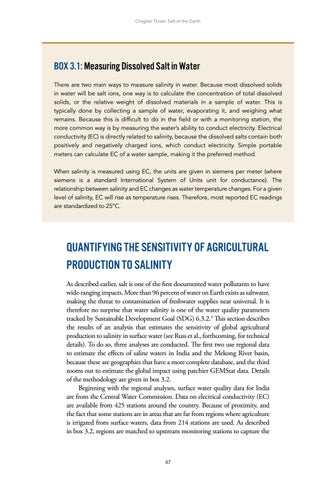Chapter Three: Salt of the Earth
BOX 3.1: Measuring Dissolved Salt in Water There are two main ways to measure salinity in water. Because most dissolved solids in water will be salt ions, one way is to calculate the concentration of total dissolved solids, or the relative weight of dissolved materials in a sample of water. This is typically done by collecting a sample of water, evaporating it, and weighing what remains. Because this is difficult to do in the field or with a monitoring station, the more common way is by measuring the water’s ability to conduct electricity. Electrical conductivity (EC) is directly related to salinity, because the dissolved salts contain both positively and negatively charged ions, which conduct electricity. Simple portable meters can calculate EC of a water sample, making it the preferred method. When salinity is measured using EC, the units are given in siemens per meter (where siemens is a standard International System of Units unit for conductance). The relationship between salinity and EC changes as water temperature changes. For a given level of salinity, EC will rise as temperature rises. Therefore, most reported EC readings are standardized to 25°C.
QUANTIFYING THE SENSITIVITY OF AGRICULTURAL PRODUCTION TO SALINITY As described earlier, salt is one of the first documented water pollutants to have wide-ranging impacts. More than 96 percent of water on Earth exists as saltwater, making the threat to contamination of freshwater supplies near universal. It is therefore no surprise that water salinity is one of the water quality parameters tracked by Sustainable Development Goal (SDG) 6.3.2.3 This section describes the results of an analysis that estimates the sensitivity of global agricultural production to salinity in surface water (see Russ et al., forthcoming, for technical details). To do so, three analyses are conducted. The first two use regional data to estimate the effects of saline waters in India and the Mekong River basin, because these are geographies that have a more complete database, and the third zooms out to estimate the global impact using patchier GEMStat data. Details of the methodology are given in box 3.2. Beginning with the regional analyses, surface water quality data for India are from the Central Water Commission. Data on electrical conductivity (EC) are available from 425 stations around the country. Because of proximity, and the fact that some stations are in areas that are far from regions where agriculture is irrigated from surface waters, data from 214 stations are used. As described in box 3.2, regions are matched to upstream monitoring stations to capture the
47
